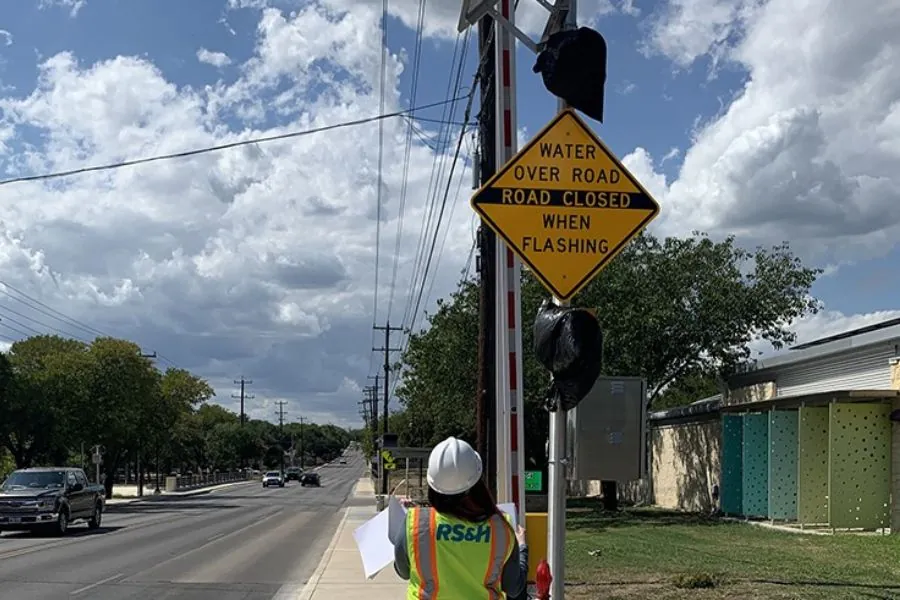High-Water Detection (HALT) Keeps Motorists Safe in Flash Flood Alley

Over the last five years, an average of 118 people have died in flash floods annually. According to FEMA, nearly half of those fatalities occur in vehicles.
Oftentimes, motorists drive into flooding waters not realizing the danger they are in. Six inches of water will reach the bottom of most passenger cars, causing a loss of control and possible stalling. A foot of water will float many vehicles.
In Bexar County, Texas, the home to San Antonio and several low-lying areas susceptible to flash floods, officials are working with RS&H to curtail those numbers and the risks for drivers.
Bexar County is in what is locally called “Flash Flood Alley” due to the nature of rain events coupled with the extreme elevation delta between the north and south parts of the county and generally impervious limestone soils in the northern, rolling terrain, said Bexar County Public Works Engineering Services Manager David Wegmann, PE, CFM.
Expanding HALT Protection
Under an on-call contract with Bexar County, RS&H is assisting with the Phase IV expansion of the High-water Alert Lifesaving Technology (HALT) system. The high-water detection system provides drivers with advance warning of impending floods and flooding events.
Bexar County has already installed more than 150 HALT systems. RS&H is responsible for the design of new sites or upgrades to existing equipment at 52 low water crossing sites in the cities of Leon Valley, Helotes, Balcones Heights, Hollywood Park, Elmendorf, and San Antonio.
“We’ve looked at FEMA floodplains and went out in the field to verify the low spots and tag them via GPS,” said RS&H traffic engineer Allie Joiner Estell. “We worked out which sensors would go where, as well as if either flashing lights or gates are needed.”
RS&H has analyzed the existing conditions, developed plans based on the FEMA floodplain maps, and is now overseeing construction and installation of all high-water detection system improvements.
Of the 52 crossing sites, 23 are new. Realizing that not every low water crossing location in Bexar County is an immediate candidate for drainage infrastructure improvements, staff and field maintenance personnel continually evaluate sites throughout the county for suitability for the installation of new HALT systems, Wegmann said.
“In addition to the needs in unincorporated Bexar County, the City of San Antonio, all suburban cities, and TxDOT were contacted to solicit a list of needs in those jurisdictions,” Wegmann added. “The 23 new installation sites are a result of that coordination, coupled with the RS&H site evaluations for installation suitability.”
Another seven of the sites will now have automatic gates, which will alleviate county road maintenance personnel from having to place barricades across the roadways during a rain event.
“Certain rural locations are difficult for maintenance personnel to barricade in a timely fashion because of a combination of distance, and accessibility during flood events,” Wegmann said. ‘”The upgrade of these specific HALT locations with automatic gates allows these sites to be closed much more expeditiously than would have been possible with the manually placed barricades.”
As Bexar County continues to enhance the functionality of its existing HALT network, 15 sites with automatic gates were selected for the trial installation of pan and zoom cameras. Utilizing views from these cameras, staff will be able to verify that flood waters have receded from the associated low water crossing, and flood debris is not blocking the travel lanes prior to those gates being raised, enhancing the county’s ability to monitor those sites.
A Life-Saving Tool
The Bexar County HALT system serves as a great example of a context-sensitive intelligent transformation systems (ITS) safety deployment. HALT systems use an intricate system of flashing beacons and gates, water level sensors, and master data collection stations in combination with graphical map displays, instant messaging, hydrological forecasting, and analysis tools.
The Bexar County HALT system uses sensors hung off bridges or culverts or along roadways to detect rising water. Once the water reaches a certain depth, the system will warn drivers to turn around with either flashing lights or a combination of flashing lights and gates.
Not only that, but the sensors are connected to alert county, city and TxDOT officials when the water levels rise.
“There are three different levels in the sensors that alert fire department and county officials if water is about to overfill an area, or is at the brim or flowing over,” Estell said. “That gives them a chance to go out and place additional barricades and stop traffic from passing through.”
Additionally, BexarFlood.org shows the road conditions of monitored low water crossings across Bexar County. By subscribing to alerts through this website, resident motorists can receive text or email alerts when low water crossings they choose to monitor have water over the road.
“Because of the communications systems built into HALT, there is the potential for it to be integrated into Bexar County’s planned virtual Traffic Management Center and overall ITS program,” Estell said.
Accuracy is imperative, as the HALT system website is now utilized by local news outlets during rain events.
“It cannot be stressed strongly enough that systems put in place to enhance public awareness of flooding and to enhance public safety be maintained and monitored constantly to ensure proper performance,” Wegmann said. “Systems that frequently report errant data, do not work, or are in disrepair are worse than having no systems at all, because the public will not be able to trust them.”
“What is great about this system is that it is alerting everyone in real-time,” Estell said. “With the warning lights and gates in place, along with the sensors going to officials and drivers alike, the HALT system here can make a real difference in what can otherwise be dangerous situations.”
